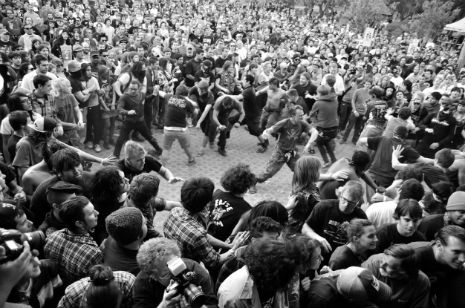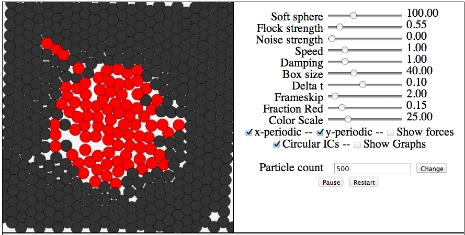

Jesse Silverberg, a graduate student at Cornell University in Ithaca, and two physics professors at Cornell are researching the science behind “what makes a crowd of people with independent decision-making powers behave like a random gas?”
Yep! According to the research by these physicists, people in mosh pits act like atoms in a gas. Apparently the studies could help architects design buildings “that ease the flow of chaotic crowds in an emergency.”
From New Scientist:
They found that the dancers’ speeds had the same statistical distribution as the speeds of particles in a gas. Such particles move around freely, interacting only when they bounce off one another.
“This presented a bit of a mystery,” Silverberg says. What makes a crowd of people with independent decision-making powers behave like a random gas?
Snip—
To investigate, the team simulated a mosh pit with a few basic rules: the virtual moshers bounce off each other when they collide (instead of sticking or sliding through each other); they can move independently; and they can flock, or follow each other, to varying degrees. Finally, the team added a certain amount of statistical noise to the simulated moshers’ movements – “to mimic the effects of the inebriants that the participants typically use”, says co-author Matthew Bierbaum.
They found that by tweaking their model parameters – decreasing noise or increasing the tendency to flock, for instance – they could make the pit shift between the random-gas-like moshing and a circular vortex called a circle pit, which is exactly what they saw in the YouTube videos of real mosh pits. Their simulation is available online.
“These are collective behaviours that you wouldn’t have predicted based on the previous literature on collective motion in humans,” Silverberg says. “That work was geared at pedestrians, but what we’re seeing is fundamentally different.”
“The fact that human beings are very complex creatures, and yet we can develop a lifeless computer simulation that mimics their behaviour, really tells us that we’re understanding something new about the behaviour of crowds that we didn’t understand before,” says co-author James Sethna.
Below, watch humans act like random atoms at the 1:38 mark.
Via Nerdcore